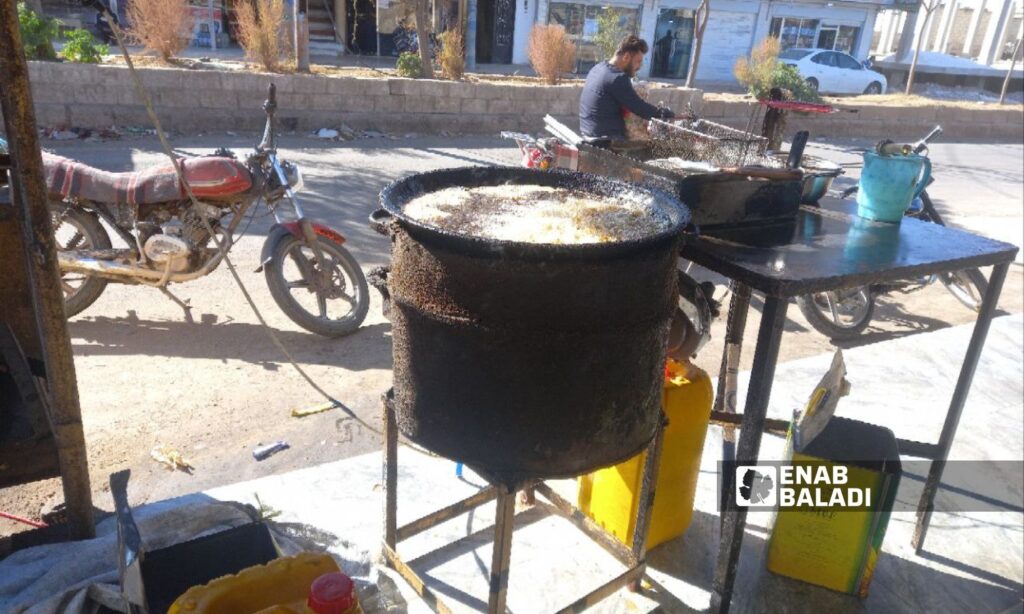Daraa – Halim Muhammad
In front of a shop selling falafel sandwiches in the city of Tafas in the western countryside of Daraa, the 40-year-old Ali al-Mohammad counts the amount he has after the seller informs him that the price of a falafel sandwich had risen by 1,000 Syrian pounds.
The price of the popular sandwich has become 5,000 pounds after it was 4,000; such an increase followed the government decision to raise the prices of unsubsidized bread of which restaurants consume large quantities.
On November 7, the Syrian regime government raised the prices of bread outside the government subsidy card, known as the “smart card,” from 1,225 Syrian pounds to 3,000 pounds for each bread bundle containing seven loaves weighing 1,100 grams, which prompted restaurant owners to raise the prices of their products in line with bread prices, according to a number of restaurant owners in Daraa.
Bread is not the only reason for the rise in food prices in restaurants, as it was preceded by the rise in the price of the industrial gas cylinder, via and without a “smart card,” from 75,000 pounds to 150,000 last September.
The US dollar is trading at 14,000 SYP according to the S-P Today website, which covers the trading rate of the Syrian pound to the dollar.
Bread and gas
Ali, who supports a family of six people, said, “It seems that the falafel sandwich has joined the list of ‘prohibited purchases’ and has joined the ranks of shawarma, grilled chicken, and broasted chicken,” pointing out that these foods are no longer bought by his family after their high prices.
Alaa al-Masri, 45, of Daraa countryside, said that the falafel sandwich was previously eaten by the poor, but today it has become impossible to buy it, indicating that he needs 20,000 Syrian pounds if he wants or thinks about buying a falafel sandwich for his four-member family. This is an amount equivalent to his daily wage in agricultural work.
Fayez, 50, the owner of a restaurant in the western countryside, told Enab Baladi that he raised the price of a falafel or potato sandwich from 4,000 to 5,000 after the rise in bread prices, pointing out that the cost of a loaf of bread ranges between 500 pounds and 600 pounds. (Transportation costs will be added to the bread price).
The price of non-industrial gas in the local market also rose to 190,000 Syrian pounds, and last September, it did not exceed 80,000.
Ahmed, 45, owner of a restaurant in the northern countryside, said that sales activity declined by half after the high prices of food in restaurants. He added that he previously prepared a skewer of shawarma weighing 40 kilograms and sold it every day, but currently, he prepares a skewer weighing 25 kilograms, which is not sold in one day.
Ahmed complained about the cost of the unsubsidized gas that he buys from the local market, as the subsidized gas allocations are not enough for a quarter of his needs. He needs approximately three gas cylinders per day, while he estimated the quantities of subsidized gas at half a cylinder per day.
Despite the appeals and demands of restaurant owners to increase the allocations, the amount is fixed and does not change, he said.
Gap between state’s pricing and sales
The owner of the restaurant, Fayez, said that there is a continuous increase in the ingredients for making food in popular restaurants, as the price of a kilo of sesame tahini reached 65,000 pounds, and at the beginning of this year it did not exceed 30,000 pounds, and a kilo of chickpeas also rose from 7,000 pounds to 13,000 pounds.
He added that the price of a liter of vegetable oil reached 25,000 pounds, and the price of starch, citric acid, and olive oil, of which the price of a 16-liter can reached one million pounds, also increased.
As for shawarma restaurants, the price of meat and chicken increased, and a kilo of veal meat reached 120,000 pounds, the price of a grilled chicken reached 100,000 pounds, and a shawarma sandwich reached 25,000 pounds.
Fayez stated that restaurant owners raise prices in order to achieve a profit margin, but the high prices led to a decline in sales and the turnout of customers, while Ahmed, another restaurant owner, said that he was thinking of closing his shop if this high price continued amid the stagnation of his sales.
The International Committee of the Red Cross estimated that nearly 90% of Syria’s population lives below the poverty line, and more than 15 million Syrians need humanitarian aid in a report it issued on June 14.

